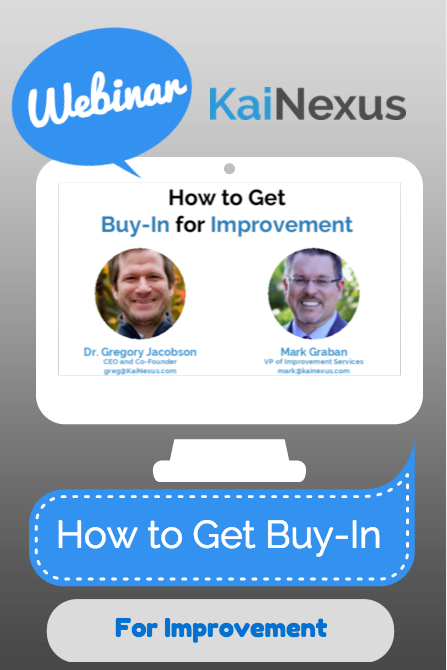If you're struggling to get buy-in for improvement in your organization, yesterday's webinar from KaiNexus' Mark Graban and Greg Jacobson might be just what you need.
In this month's webinar, Mark and Greg dive deep into what buy-in is, why it's hard to get, and what you need to do differently in order to attain it.
I'll give a synopsis of the webinar here, but for the full effect, you should definitely watch it here (also available on the KaiNexus Podcast, for those of you who are crunched for time).
How to Increase Buy-In For Improvement
Essentially, they say that the reason for a lack of buy-in for improvement boils down to be one of two things:
- A lack of information about what Lean is, or
- A lack of leadership
This makes a lot of sense. People often have a gut reaction to hearing the word Lean - and frequently, it's not a good reaction. That's where the second reason comes in. As a leader, it's your job to fix that.
The important thing to remember in all of this is that lack of buy-in is NOT the problem. It's a SYMPTOM of the problem. In order to increase buy-in, we need to understand what the problems are and address those.
Mark and Greg list a few common objections that inhibit buy-in, including:
- People hear Lean and think layoffs, either from the (untrue) reputation that precedes Lean or from past experience in a bad "Lean" culture.
- They think that while Lean is good for some companies, theirs is different because ___ (insert reason here). Mark calls this "differentism" in the webinar, which I love.
- People don't understand the need for change
- They disagree over what problems to solve
- Lower-level goals are not aligned properly with organizational goals
Another thing we hear a lot of people struggling with is an inability to get buy-in for software that supports an improvement culture. This is tough to overcome because it's pretty easy for one person to derail a project (like software implementation) that they find threatening or don't understand.
Common reasons people give for a lack of buy-in as relates to software is:
- "I don’t have time to use it"
- "I didn’t have a say in choosing it"
- "Lack of training on the system"
- "System doesn’t work well, or is too slow"
- "The system isn’t compatible with our workflows"
As hard as it is, we need to remember not to blame the person that isn’t buying the improvement method you're selling.
If they’re not buying, it’s because you aren’t selling well enough.
Harsh, I know.
The resistance to change is proportional to your lack of leadership.
- Stephen Parry
Mark and Greg emphasize a lot in the webinar that you have to engage hearts and minds when trying to move your organization toward an improvement culture.
You can't force people to change; instead, let them be a part of the decision.
Consulting them when developing a plan for improvement shows people that you respect their input, and that goes a long way toward getting everyone on the same page about improvement.
People don’t resist change, they resist being changed.
- Peter Scholtes
Greg dives deep into biology for a few minutes at this point, referencing a blog post that we published a while back written by Dr. Mark Jaben about decision making and resistance to change.
You can read the full post for more information, but the gist of it is that our core beliefs are held in the Hidden Brain - the subconscious - rather than our centers of rational thinking, and as such, the way people feel about the change you propose matters just as much as any logical facts and figures you throw their way.
So how does appealing to hearts and minds look in practice? Let's look at a couple examples covered in the webinar.
GOAL: Implement Lean
The wrong thing to say: Let's go implement Lean!
The right thing to say: Let's go improve ____ (insert a shared goal here).
 While the first option leaves much open to interpretation on the part of the people you're talking to, the second option rallies people around a common goal. For example, when speaking to a group of physicians, you might suggest that they improve patient outcomes. Obviously, they all want to do that.
While the first option leaves much open to interpretation on the part of the people you're talking to, the second option rallies people around a common goal. For example, when speaking to a group of physicians, you might suggest that they improve patient outcomes. Obviously, they all want to do that.
Once you have everyone agreeing on the shared outcome, they'll be more receptive to your proposed method of getting there.
In the webinar, Mark and Greg give specifics for increasing buy-in from front-line employees, managers, and senior leaders. They present one set of questions from Professor Mitchell Lee Marks, though, that applies to everyone.
- Are you showing people that you understand the difficulties they will face?
- Are you giving people the information they need to understand the case for change?
- Are people being given the opportunity to express and discuss their feelings about the transition?
- Are you inspiring people with a detailed vision of the company’s future, and what matters for getting there, and providing both emotional and practical support as they work out their new roles?
- Are you involving people at every level in translating the company’s vision into new operating procedures?
If you answered no to any one of these, that's an area you can improve upon to better lead the culture change.
For executives specifically, Mark and Greg highlight key points from a previous webinar entitled "What Keeps The C-Suite Up At Night." (Watch that here).
- Don’t sell improvement as just being the right thing to do; they need to understand why
- Link improvement initiatives to organizational strategy
- Articulate the impact (both financial and otherwise)
- identify how you'll leverage and develop talent within the organization
Closing points of the webinar include:
- Start with “Why:" identify your goals, not just action.
- Don’t go into a conversation thinking that you’re going to convince someone of something huge. Shoot for a small "Yes," and work toward a big one.
- Know your audience, and speak to their interests.
There's the webinar in a nutshell! Click here to watch the full thing.




Add a Comment